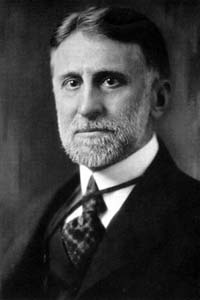Terrestrial magnetism was developing into a distinct field of study at the opening of the 20th Century, and one man propelled it to international prominence as its champion: Louis Agricola Bauer.
 |
| Louis Agricola Bauer |
Louis Bauer was born in Cincinnati, Ohio, on January 26, 1865 to German parents. He preferred that his first name be given the French pronunciation, and having been given no middle name, he jokingly chose for himself "Agricola," the Latin translation of his German last name meaning "farmer." He married Adelia Frances Doolittle in 1891 and they had one child, Dorothea Louise.
Bauer first attended college at the University of Cincinnati and earned a degree in Civil Engineering in 1888. He was employed with the United States Coast and Geodetic Survey as a computer between 1887 and 1892. During this time he became interested in geomagnetism and left the USCGS for Berlin to study physics and geophysics under such revered scientists as Max Planck and Adolf Schmidt. His doctoral dissertation in 1895 was a mathematical analysis of secular variation in the earth's magnetic field.
 |
| Bauer aboard the Galilee |
Bauer returned to the United States with a singular mission: to promote geomagnetism, then called "terrestrial magnetism," as a scientific field on par with astronomy or meteorology. In 1896 he founded the international journal Terrestrial Magnetism, the forerunner of today's Journal of Geophysical Research, and began teaching and working with the Maryland State Geological Survey on what was considered to be the first state-funded geomagnetic survey of great importance. In 1899 he left the Maryland Survey to accept a position as chief of the newly-established Division of Terrestrial Magnetism in the USCGS where he had worked seven years earlier. While at USCGS, Bauer led the division in making extensive observations of the magnetic field in the United States and established five permanent magnetic observatories around the country.
After five years with the USCGS, Bauer was ready to push further. The Division had been successful domestically, but Bauer saw terrestrial magnetism as a world-wide effort – one that required central coordination of international surveys. The USCGS could not function as an international bureau, but such a role could be assumed by the Carnegie Institution of Washington (now known as the Carnegie Institution for Science), a private non-governmental research organization established in 1902 with an endowment from industrialist Andrew Carnegie. In 1904 the Institution decided to fund Bauer's vision by establishing a Department of International Research in Terrestrial Magnetism, later shortened to the Department of Terrestrial Magnetism, or DTM, and making Bauer its director.
Bauer served as Director of the Department of Terrestrial Magnetism from 1904 until 1930. However, in 1927 he suffered a mental breakdown while in Europe. He retained the title of Director until 1930, but did not act as such while his mental facilities were evaluated. Two years later, on April 12, 1932, Bauer committed suicide.
